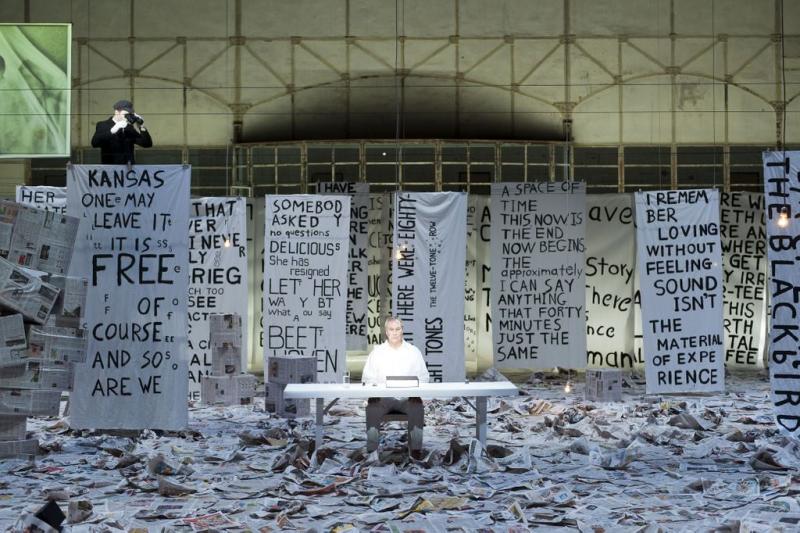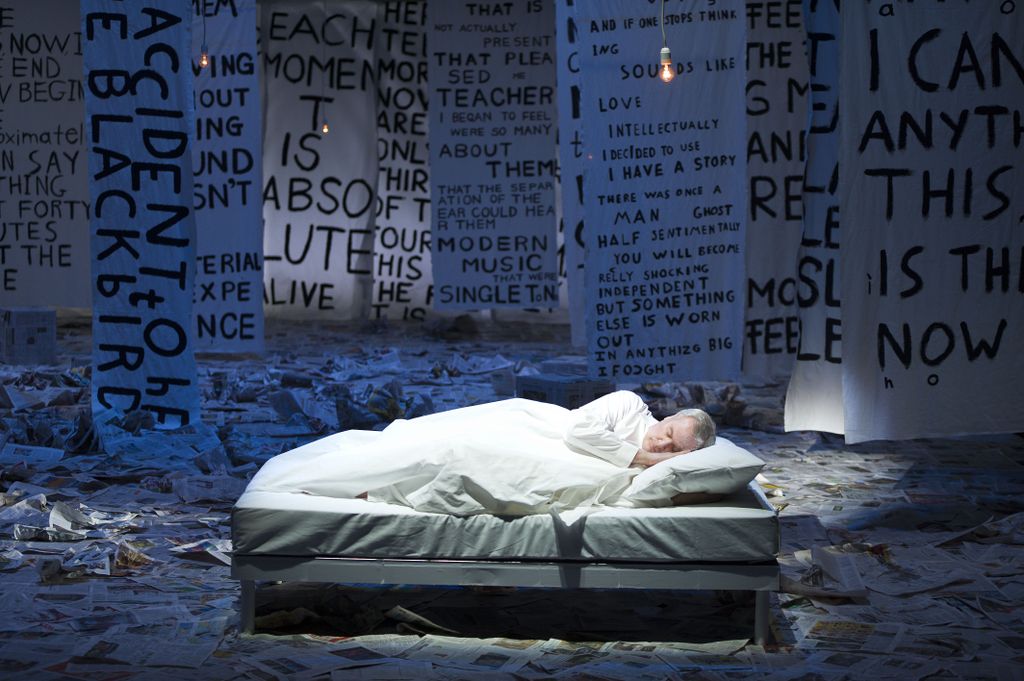John Cage Lecture on Nothing, Barbican Theatre | reviews, news & interviews
John Cage Lecture on Nothing, Barbican Theatre
John Cage Lecture on Nothing, Barbican Theatre
Silence speaks volumes in Robert Wilson's new staging of a John Cage classic

“I have nothing to say, and I am saying it. And that is poetry.” Originally delivered by John Cage at an artists’ club in New York in 1949, the composer’s Lecture On Nothing went on to become a core text within his 1961 collage-meditation of essays, Silence.
Wilson’s affinity for the American minimalism of this period is most famously explored in his quasi-operatic collaboration with Philip Glass, Einstein on the Beach, and it’s only a very small ritual stroll from this world of white-faced human automata and organic visual patterning to Cage’s verbal tone-poem of repetitions and self-reflexive abstraction. But while Einstein’s dominant mood is of disturbance and threat, Cage’s linguistic fantasy is altogether more playful, more benign.
The concept of nothingness is fragmented, fractured and reconfigured
Delivered by Wilson himself, the text’s five sections construct an architecturally elaborate hall of mirrors, reflecting the lecture’s own processes back on itself and muddling thoughts on form and material with meticulously casual effect. The concept of nothingness (and the implied relationship between nothing, Nothing, and no-thing) is fragmented, fractured and reconfigured, subjected to an associative sequence of tests and assaults. Wilson’s set defers the absolute nullity of Cage’s silence one stage further with the clamour of its visuals - a floor strewn with scrunched-up newspapers crying their headlines, banners screaming theirs.
 It could all be insufferably smug were it not for Cage’s own quiet wit and Wilson’s precisely pitched delivery. The repetitions of section four see verbal signs and signifiers part company, with words finding new freedom in their circling formations. Physicality (occasionally deployed for an easy laugh - welcome, on balance - in this potentially tense setup) brings tensions and reassurances to the text, though there’s no attempt to dramatise the work as such.
It could all be insufferably smug were it not for Cage’s own quiet wit and Wilson’s precisely pitched delivery. The repetitions of section four see verbal signs and signifiers part company, with words finding new freedom in their circling formations. Physicality (occasionally deployed for an easy laugh - welcome, on balance - in this potentially tense setup) brings tensions and reassurances to the text, though there’s no attempt to dramatise the work as such.
While the notion of an auditorium full of people leaving their homes and offices on a freezing Monday evening to contemplate nothing in the Barbican is antithetical to Cage’s fluid concept of art and culture, there’s an elegance to the irony that Wilson (pictured above) is eager to enjoy and exploit. There is poetry here of a more profound kind than the musical wisecrack of 4'33" and Cage’s writing more than justifies the weight and significance that Wilson’s performance ascribes to it.
In a neat gesture, Wilson’s own narration gives way at the core of the un-argument to silence, allowing Cage’s own voice to take over in recorded form. This staging of the Lecture On Nothing is a duet of gorgeous fluency between two natural partners, each instinctively in sympathy with the other. We the audience may have found ourselves “going nowhere”, but the journey has rarely been so scenic or filled with ideas.
The future of Arts Journalism
You can stop theartsdesk.com closing!
We urgently need financing to survive. Our fundraising drive has thus far raised £49,000 but we need to reach £100,000 or we will be forced to close. Please contribute here: https://gofund.me/c3f6033d
And if you can forward this information to anyone who might assist, we’d be grateful.

Subscribe to theartsdesk.com
Thank you for continuing to read our work on theartsdesk.com. For unlimited access to every article in its entirety, including our archive of more than 15,000 pieces, we're asking for £5 per month or £40 per year. We feel it's a very good deal, and hope you do too.
To take a subscription now simply click here.
And if you're looking for that extra gift for a friend or family member, why not treat them to a theartsdesk.com gift subscription?
more Theatre
 Works and Days, Edinburgh International Festival 2025 review - jaw-dropping theatrical ambition
Nothing less than the history of human civilisation is the theme of FC Bergman's visually stunning show
Works and Days, Edinburgh International Festival 2025 review - jaw-dropping theatrical ambition
Nothing less than the history of human civilisation is the theme of FC Bergman's visually stunning show
 Every Brilliant Thing, @sohoplace review - return of the comedy about suicide that lifts the spirits
Lenny Henry is the ideal ringmaster for this exercise in audience participation
Every Brilliant Thing, @sohoplace review - return of the comedy about suicide that lifts the spirits
Lenny Henry is the ideal ringmaster for this exercise in audience participation
 Edinburgh Fringe 2025 reviews: The Beautiful Future is Coming / She's Behind You
A deft, epoch-straddling climate six-hander and a celebration (and take-down) of the pantomime dame at the Traverse Theatre
Edinburgh Fringe 2025 reviews: The Beautiful Future is Coming / She's Behind You
A deft, epoch-straddling climate six-hander and a celebration (and take-down) of the pantomime dame at the Traverse Theatre
 Good Night, Oscar, Barbican review - sad story of a Hollywood great's meltdown, with a dazzling turn by Sean Hayes
Oscar Levant is an ideal subject to refresh the debate about media freedom
Good Night, Oscar, Barbican review - sad story of a Hollywood great's meltdown, with a dazzling turn by Sean Hayes
Oscar Levant is an ideal subject to refresh the debate about media freedom
 Edinburgh Fringe 2025 reviews - Monstering the Rocketman by Henry Naylor / Alex Berr
Tabloid excess in the 1980s; gallows humour in reflections on life and death
Edinburgh Fringe 2025 reviews - Monstering the Rocketman by Henry Naylor / Alex Berr
Tabloid excess in the 1980s; gallows humour in reflections on life and death
 Edinburgh Fringe 2025 reviews: Lost Lear / Consumed
Twists in the tail bring revelations in two fine shows at the Traverse Theatre
Edinburgh Fringe 2025 reviews: Lost Lear / Consumed
Twists in the tail bring revelations in two fine shows at the Traverse Theatre
 Make It Happen, Edinburgh International Festival 2025 review - tutting at naughtiness
James Graham's dazzling comedy-drama on the rise and fall of RBS fails to snarl
Make It Happen, Edinburgh International Festival 2025 review - tutting at naughtiness
James Graham's dazzling comedy-drama on the rise and fall of RBS fails to snarl
 Edinburgh Fringe 2025 reviews: I'm Ready To Talk Now / RIFT
An intimate one-to-one encounter and an examination of brotherly love at the Traverse Theatre
Edinburgh Fringe 2025 reviews: I'm Ready To Talk Now / RIFT
An intimate one-to-one encounter and an examination of brotherly love at the Traverse Theatre
 Top Hat, Chichester Festival Theatre review - top spectacle but book tails off
Glitz and glamour in revived dance show based on Fred and Ginger's movie
Top Hat, Chichester Festival Theatre review - top spectacle but book tails off
Glitz and glamour in revived dance show based on Fred and Ginger's movie
 Edinburgh Fringe 2025 reviews: Alright Sunshine / K Mak at the Planetarium / PAINKILLERS
Three early Fringe theatre shows offer blissed-out beats, identity questions and powerful drama
Edinburgh Fringe 2025 reviews: Alright Sunshine / K Mak at the Planetarium / PAINKILLERS
Three early Fringe theatre shows offer blissed-out beats, identity questions and powerful drama
 The Daughter of Time, Charing Cross Theatre review - unfocused version of novel that cleared Richard III
The writer did impressive research but shouldn't have fleshed out Josephine Tey’s story
The Daughter of Time, Charing Cross Theatre review - unfocused version of novel that cleared Richard III
The writer did impressive research but shouldn't have fleshed out Josephine Tey’s story
 Evita, London Palladium review - even more thrilling the second time round
Andrew Lloyd Webber's best musical gets a brave, biting makeover for the modern age
Evita, London Palladium review - even more thrilling the second time round
Andrew Lloyd Webber's best musical gets a brave, biting makeover for the modern age

Add comment